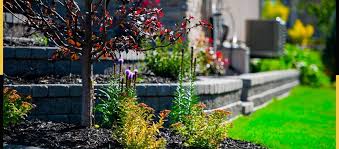As environmental awareness grows, sustainable landscaping has become increasingly popular among homeowners looking to make a positive impact. Eco-friendly gardening practices not only create beautiful outdoor spaces but also support biodiversity, conserve water, reduce waste, and promote soil health. Whether you’re starting from scratch or updating your current landscape, here are some top eco-friendly ideas to help you cultivate a greener garden. For more information check out landscaping companies in dubai
1. Choose Native Plants
Using native plants is one of the most effective ways to create an eco-friendly garden. These plants are naturally adapted to the local climate, soil, and ecosystem, which makes them low-maintenance and resilient. Native plants require less water, fertilizer, and pesticides, reducing the need for artificial inputs. They also provide essential food and habitat for local wildlife, such as pollinators like bees, butterflies, and birds.
To get started, research plants native to your region and consider how they’ll thrive in your garden’s sunlight and soil conditions. You’ll find a wide variety of options, from wildflowers to shrubs, that can add both beauty and biodiversity to your landscape.
2. Practice Xeriscaping
Xeriscaping is a landscaping approach that emphasizes water conservation. This technique involves selecting drought-tolerant plants, using mulch to retain moisture, and designing areas that minimize water use. For instance, succulents, lavender, and ornamental grasses are excellent choices for xeriscaped gardens, as they thrive in dry conditions.
Incorporate drip irrigation systems to water your plants efficiently, delivering water directly to the root zone and reducing evaporation. Xeriscaping not only reduces your water usage but also helps your garden remain lush and healthy even in arid seasons.
3. Create a Rain Garden
A rain garden is a planted depression in your yard that captures rainwater runoff, allowing it to naturally infiltrate the soil. Rain gardens reduce water runoff, prevent soil erosion, and filter pollutants, helping to protect local waterways. These gardens are often planted with native grasses, wildflowers, and shrubs that tolerate both wet and dry conditions.
Position a rain garden near areas where water naturally flows, such as downspouts or low-lying parts of your yard. This feature not only provides a habitat for birds and pollinators but also adds a unique and vibrant element to your garden.
4. Use Organic Mulch and Compost
Organic mulch is a valuable addition to sustainable landscaping, offering multiple benefits. By covering soil with materials like wood chips, leaves, or straw, you can help retain moisture, suppress weeds, and regulate soil temperature. As the mulch decomposes, it enriches the soil with nutrients, promoting healthy plant growth.
Similarly, adding compost to your garden soil is an excellent way to improve soil fertility without synthetic fertilizers. Compost made from kitchen scraps, yard waste, and organic material provides essential nutrients for plants, improves soil structure, and supports beneficial microorganisms. Together, organic mulch and compost create a foundation for a thriving, eco-friendly garden.
5. Incorporate Pollinator-Friendly Plants
Pollinators such as bees, butterflies, and hummingbirds play a crucial role in the ecosystem by helping plants reproduce. Creating a pollinator-friendly garden involves selecting plants that produce nectar and pollen and bloom at different times of the year, ensuring a consistent food source for pollinators. Examples of pollinator-friendly plants include sunflowers, coneflowers, lavender, and milkweed.
Consider avoiding pesticides, as many are harmful to pollinators. Instead, encourage a balanced ecosystem by attracting natural predators like ladybugs and birds, which can help control pests naturally.
6. Install Permeable Paving
Traditional concrete and asphalt surfaces prevent water from seeping into the ground, causing runoff and erosion. Permeable paving solutions, such as gravel, pavers, or porous concrete, allow rainwater to soak through the ground, replenishing groundwater supplies and reducing stormwater runoff.
By installing permeable paths and patios, you can improve water management on your property and add a unique, modern touch to your landscape. Permeable pavers come in a variety of colors and shapes, allowing for a beautiful, eco-friendly alternative to conventional hardscapes.
7. Use Solar Lighting
Outdoor lighting adds both functionality and ambiance to a garden, but traditional electric lights consume energy. Solar-powered lights, however, are an excellent eco-friendly option, as they use renewable energy and don’t require wiring. Solar garden lights are easy to install, come in various designs, and can highlight pathways, flower beds, and patios.
Opting for solar lighting not only helps lower your energy consumption but also creates a charming, warm glow that enhances your outdoor space in an environmentally friendly way.
8. Implement Companion Planting
Companion planting is a technique that involves growing different plants close together to benefit each other, improve soil health, and naturally deter pests. For example, planting marigolds with tomatoes can help repel insects, while basil near peppers can enhance their flavor and promote growth.
This approach reduces the need for chemical pesticides and fertilizers, helping you maintain a balanced, organic garden ecosystem. Companion planting also maximizes your garden’s productivity by encouraging beneficial interactions among plants.
9. Harvest Rainwater
Installing a rainwater harvesting system is a simple and effective way to reduce your reliance on municipal water for gardening. Rain barrels collect water from your roof, providing a free, sustainable water source for your garden during dry periods. This eco-friendly practice is especially beneficial in regions with seasonal droughts or water restrictions.
Rainwater is typically free of salts and chemicals found in tap water, making it ideal for plants. A single barrel can collect hundreds of gallons of water annually, making it a valuable addition to any sustainable garden.
10. Plant Trees for Shade and Carbon Sequestration
Trees play a vital role in sustainable landscaping by providing shade, improving air quality, and sequestering carbon dioxide. Strategically planting trees around your property can reduce the need for air conditioning in the summer, lowering energy consumption. Trees like oaks, maples, and pines offer aesthetic appeal, provide shelter for wildlife, and improve soil health through their root systems.
When choosing trees, consider native varieties and plant them with enough space to grow fully without impacting your home or utility lines. The long-term benefits of trees make them a worthwhile investment in any eco-friendly landscape.
Design a Greener Garden, One Step at a Time
By incorporating these eco-friendly landscaping ideas, you can create a sustainable, low-maintenance garden that benefits the environment while enhancing the beauty of your outdoor space. Sustainable landscaping goes beyond aesthetics; it’s a commitment to reducing resource use, supporting biodiversity, and contributing to a healthier ecosystem. Embrace these green practices to transform your garden into a model of sustainability that you, your family, and future generations can enjoy.










